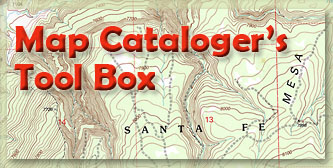
Map Cataloging Workshop Schedule
June 8, 2006
David J. Bertuca, Map Librarian
University Libraries, University at Buffalo
Maps and cartographic materials (e.g., maps, charts, satellite and aerial photographs, atlases) constitute a large body of important items that have value in all fields of life and learning. Libraries may have special collections or just small files of maps. Either way, these items generally are not given the full access that books and standard format items do. Sometimes this is because there are not enough maps to catalog regularly, or there is no policy regarding this format. No matter what the reason, few institutions have map catalogers, or specialists in working with cartographic materials alone.
Breaks and hands on practice sessions will be added as the day progresses.
Introduction to Maps and Cartographic Materials
- Maps and Cartographic Resources: Description of the format and related items. Also, what they are and why catalog them
- Categories of maps (i.e., topographic, planimetric, etc.), projection, and other aspects
- Reading maps for content and use
Cataloging Maps
- MARC Format for Maps
- Order of fields
- Essential fields
- Description
- Reading maps for description
- Key data (i.e., author, agency, dates, etc.)
- Projection
- Scale (and how to determine if it is not indicated)
- Geographical coordinates (latitude/longitude)
- Important features of the map not covered in
author/title/responsibility statements
- Using note fields
- Order of note fields
- Types of notes
Call numbers and Subject Headings
- Devising Call Numbers
- Selecting and Creating Subject Headings
Map Resources online and print
- Locating and Developing Resources to Assist in Map Cataloging
- Print Resources (e.g., gazetteers, geographical dictionaries, guides, and atlases)
- Computer Resources (both on a PC and on the WWW)
Developing your own map resources and references
- Personal files and databases (paper and computer)
Additional Topics and Summary
- Where to go for more (e.g., associations)
This workshop is intended to provide basic to intermediate instruction on cataloging maps and cartographic materials. By use of examples and discussion, attendees will be able to catalog such items. At the end of the workshop, participants will:
*learn about the MARC maps format and what
items are included
*learn procedures for cataloging maps, including:
how to read map data to determine its form and content
how to describe the physical map and interpret this description into MARC
format
how to create notes
how to formulate LC call numbers
how to create subject headings and subdivisions
how to find map and geographical information (both print and online resources)
how to develop resources to assist with map cataloging (both published
tools and personal ones).
This workshop will also be useful for librarians who need to handle map and geography reference questions.
Through the use of examples and short exercises with real maps, participants will be able to practice and develop a feel for what is needed to produce catalog records. Examples will include both common and unusual pieces, which will be matched to catalog records to help visualize the creation of the records.
Materials covered in the workshop will include
the key tools, such as AACRII, Cataloging Service Bulletins, LC Schedule
G, LC Subject Headings, LC Map Cataloging Manual, and others. Participants
will also be shown resources developed by associations of map librarians,
and resources developed by the instructor to assist in map cataloging.
Note: Participants may wish to bring a map (either unique or common) that
can be cataloged on site. The instructor will be bringing examples and
the corresponding catalog records along with various tools used to catalog.
David J. Bertuca, Map Librarian, University at Buffalo.
4 October 2003
URL: http://ublib.buffalo.edu/libraries/asl/maps/cat/map_cataloging_workshop.html
Back to: Map Cataloger's Tool Box